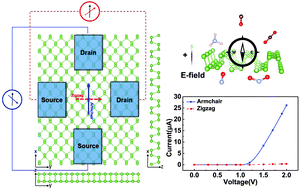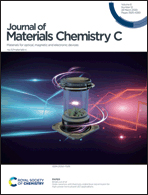Black arsenene as a promising anisotropic sensor with high sensitivity and selectivity: insights from a first-principles investigation†
Abstract
Black arsenene (B-As), a monolayer of arsenic, is of general interest due to its considerable bandgap, high carrier mobility, anisotropic nature and ideal stability under ambient conditions. In the present study, the adsorption of NH3, CO, CO2, NO, and NO2 on B-As was investigated using first-principles simulations to exploit the potential of B-As as a gas sensor. The binding strengths between the molecules and B-As were uncovered and could be modulated by a vertical electric field due to charge transfer variations but were insensitive to equibiaxial tensile strain. Our results show that B-As is more sensitive to nitrogen-containing gases. We further investigated the current–voltage (I–V) relationship using the nonequilibrium Green's function (NEGF) formalism. The transport features show large anisotropy along different directions (armchair and zigzag), which is consistent with the anisotropic band structure of B-As. Interestingly, the I–V relationship exhibits distinct responses with a marked change of the I–V curves along either the armchair or zigzag directions depending on the type of molecule. Spin polarized currents after the adsorptions of NO and NO2 were also obtained, which indicates that B-As has a superior wide-range application as a gas sensor.



 Please wait while we load your content...
Please wait while we load your content...